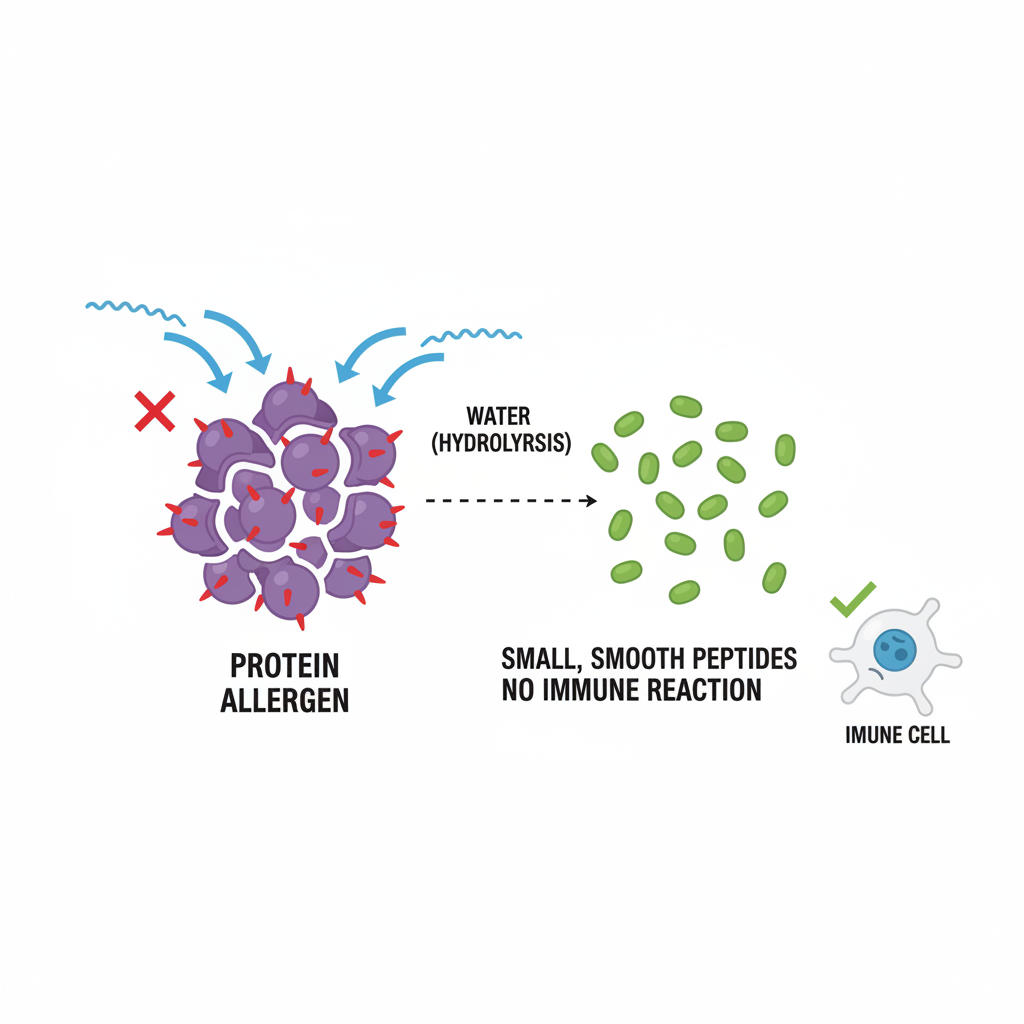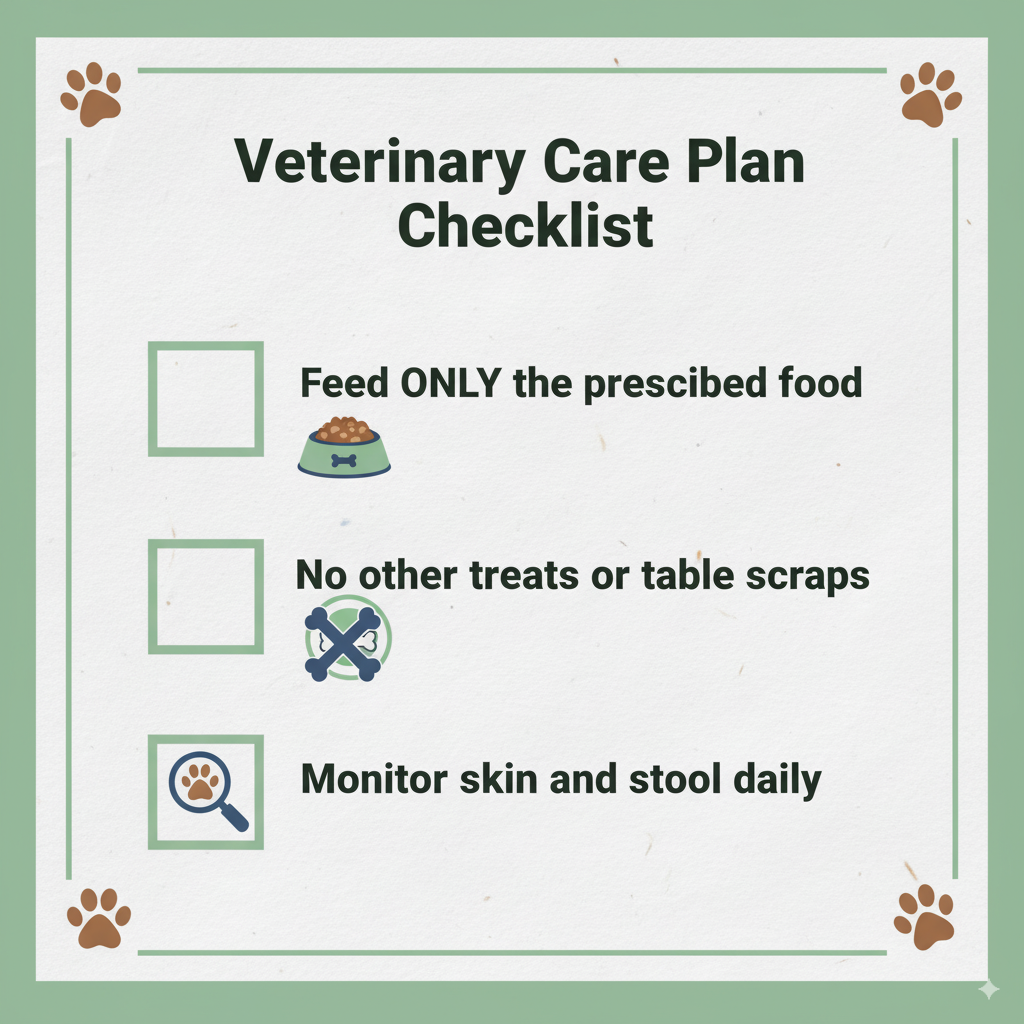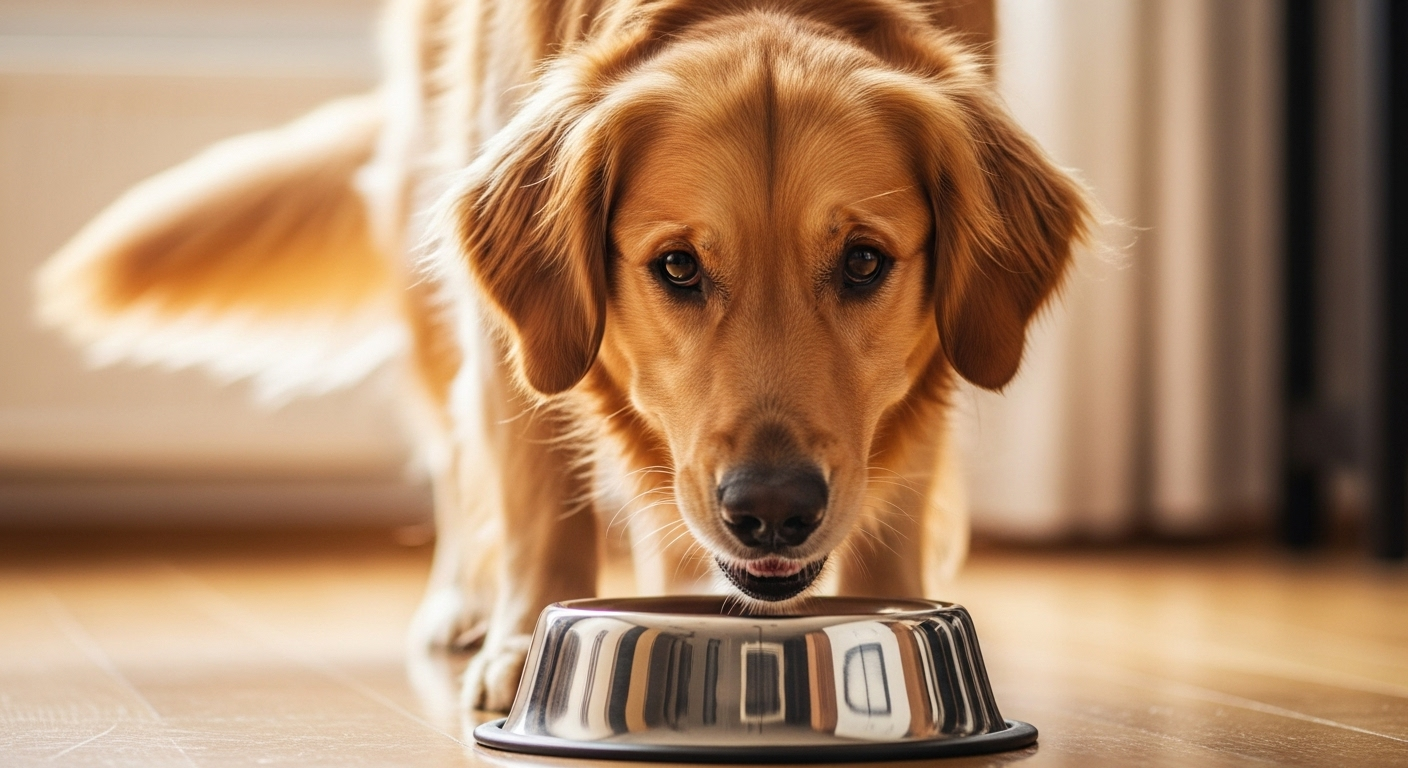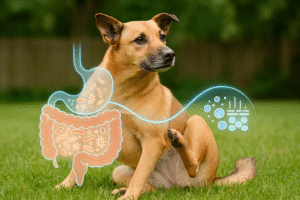This article is for informational purposes only and does not constitute medical advice. Always consult with your licensed veterinarian before making any changes to your dog’s diet or health routine.
Last reviewed: September 1, 2025
Watching your dog suffer from constant scratching or relentless digestive upset is frustrating and heartbreaking. You’ve tried everything, but nothing seems to bring lasting relief. As a veterinarian, I’ve seen this struggle countless times. Often, the answer lies not in a medicine bottle, but in their food bowl.
Table of Contents
Key Takeaways
A hydrolyzed protein diet for dogs is a special therapeutic food designed to manage adverse food reactions (AFRs). The core idea is simple: proteins are broken down into tiny fragments that the dog’s immune system is less likely to recognize as allergens. This makes it a powerful tool for both diagnosing food allergies through a strict elimination trial and providing long-term relief for dogs with sensitive skin or stomachs. A successful diet trial requires absolute commitment for 4 to 12 weeks, meaning no other treats, table scraps, or flavoured medications. While more expensive than regular kibble, a hydrolyzed protein diet for dogs can significantly improve your pet’s quality of life.
What is a Hydrolyzed Protein Diet for Dogs, Really?
In simple terms, a hydrolyzed protein diet for dogs is a food where the protein source, like chicken or soy, has been broken down into very small pieces. Think of it like this: your dog’s immune system is a security guard that recognizes certain whole proteins as intruders, triggering an allergic reaction. This diet chops those intruders into such tiny, disguised fragments that they can sneak past the guards without setting off the alarm.
From my years in clinical practice, this is one of the most reliable tools we have for tackling suspected food allergies, a conclusion supported by clinical research. Studies have confirmed that these diets can be highly effective for the long-term management of conditions like canine chronic small bowel enteropathy.”. Instead of guessing which ingredient is the culprit, we offer a food that is scientifically designed to be less allergenic.
How Hydrolysis Works to “Hide” Allergens
The science behind this process is called hydrolysis. In the manufacturing of a hydrolyzed protein diet for dogs, proteolytic enzymes are used to chop up the intact proteins into small peptides. The goal is to create protein pieces so small, typically less than 13 kilodaltons (kDa) in molecular weight, that they are unlikely to be detected by the immune system. The main goal of hydrolyzing a protein is to break it down to a size that removes existing allergens, thereby avoiding recognition by patients sensitized to the intact protein. This process effectively makes the protein source invisible to the parts of the body that would normally launch an allergic attack.

7 Proven Benefits of a Hydrolyzed Protein Diet for Dogs
Switching to a hydrolyzed protein diet for dogs isn’t just about changing food; it’s a strategic veterinary treatment with specific, measurable goals. This approach provides a clear path forward for dogs suffering from food-related health issues.
1. A Reliable Tool for Diagnosing Food Allergies
One of the biggest challenges in veterinary medicine is confirming an adverse food reaction (AFR). The only way to get a true diagnosis is with a strict elimination diet trial, and a hydrolyzed protein diet for dogs is often the gold standard for this test. Because it’s difficult for owners to recall every single thing their dog has ever eaten, choosing a truly “novel” protein (one the dog has never been exposed to) can be nearly impossible. A hydrolyzed diet bypasses this problem, offering a dependable starting point for the diagnostic process.
2. Soothes Itchy Skin from Cutaneous Adverse Food Reactions
From my veterinary experience, the most common reason for prescribing a hydrolyzed dog food is for relentless skin issues. If your dog is constantly scratching, licking its paws, or suffering from ear infections, a food allergy could be the underlying cause. These diets are specifically designed to reduce the immune response that leads to pruritus, the medical term for itching. For dogs with skin-related food allergies, it takes longer for the body to clear potential allergens and for inflammation to subside. Cutaneous signs, therefore, may require at least 4 to 12 weeks on the diet to see a full benefit. In contrast, gastrointestinal upset often responds much faster, with issues like diarrhea sometimes improving in as little as one week.”
3. Calms Small Bowel Gastrointestinal Upset
For dogs experiencing chronic vomiting, diarrhea, or bloating, a hydrolyzed protein diet for dogs can bring significant relief. These signs often point to an issue in the small intestine. Veterinary therapeutic diets that are low in fibre are often the first choice for these cases. In a successful diet trial, GI signs typically improve within 2 to 3 weeks, a much faster response than what is seen with skin conditions.
4. Supports Dogs with Large Bowel GI Issues
Sometimes, digestive problems originate in the large bowel, leading to signs like colitis, which often involves straining to defecate, mucus in the stool, or needing to go outside urgently. In these situations, a hydrolyzed protein diet for dogs with a higher fibre content can be beneficial. The added fibre helps regulate digestion and promote healthier stool quality, addressing the specific needs of the large intestine while still minimizing the risk of an allergic reaction.
5. Manages Concurrent Health Conditions
Dogs, like people, can have more than one health issue at a time. The good news is that veterinary nutrition companies have developed specialized formulas for a hydrolyzed protein diet for dogs that also address other common problems. There are options designed for dogs with chronic kidney disease, urinary stones, pancreatitis (fat intolerance), and even obesity. This allows us to manage a dog’s food allergy without compromising the care for their other medical needs, which is a significant advantage in complex cases.
6. Provides Complete Nutrition During Treatment
A common concern for pet owners is whether a therapeutic diet is nutritionally complete. Rest assured, a hydrolyzed protein diet for dogs is formulated to provide all the essential nutrients your dog needs for long-term health. Many are designed for adult maintenance, and there are even specific formulations, like the Royal Canin Veterinary Diet Hydrolyzed Protein Puppy food, that are appropriate for growing puppies. Your dog gets the allergy relief they need without missing out on vital nutrition.
7. Offers Peace of Mind for Pet Owners
As a veterinarian working with small animals, I know that the most valuable benefit is often the emotional one. Living with a chronically ill pet is stressful. A hydrolyzed protein diet for dogs offers a clear, structured plan. It moves you from a place of uncertainty and trial-and-error to a targeted, vet-recommended strategy. Seeing your dog finally stop scratching or having normal stool is a profound relief that cannot be overstated.
How to Choose the Right Hydrolyzed Protein Diet for Your Dog
With several brands available, the choice can seem overwhelming. However, this is not a decision to make alone. The right hydrolyzed protein diet for dogs is a prescription that should be chosen by your veterinarian. They will consider your dog’s complete health history, including any other medical conditions and their previous food exposures, to select the most appropriate formula to start with.
The Critical Role of a Strict Elimination Diet Trial
The success of a hydrolyzed protein diet for dogs hinges on one thing: 100% compliance. The diet trial is a strict diagnostic test. For it to work, your dog can consume nothing else—no treats, no dental chews, no table scraps, no flavoured medications, and no raiding the cat’s bowl. The trial must last for a minimum period to see results, typically 2 to 3 weeks for GI issues and a longer 4 to 12 weeks for skin conditions.

At-Home Care Checklist for Your Dog’s Diet Trial
- Feed Exclusively: Only the prescribed hydrolyzed protein diet for dogs should pass your dog’s lips.
- Secure All Other Food: Ensure other pet food, human food, and even garbage are inaccessible.
- Use Hydrolyzed Treats Only: If you must give treats, use only the specific hydrolyzed treats from the same brand as the food.
- Check Medications: Speak with your vet to ensure any flavoured medications or supplements are approved or switched to a non-flavoured alternative.
- Inform Everyone: Make sure every family member, visitor, and dog-sitter understands the strict rules.
- Monitor and Record: Keep a simple journal of your dog’s skin itchiness, energy levels, and stool quality to track progress.

Cost of a Hydrolyzed Protein Diet for Dogs in Canada (2025)
A therapeutic diet is an investment in your dog’s health. Prices can vary based on the brand, your location, and your veterinary clinic’s pricing. Here is a sample of starting prices from a Canadian veterinary supplier to provide a more concrete estimate for 2025.
https://shop.centralvet.ca/collections/allergies-sensitivities-dog-food
Note: These are starting prices for the smallest available bag sizes, based on data from late 2023. Prices for larger bags will be higher. Please consult your veterinarian for exact pricing..
4 Essential Tips for a Successful Diet Transition
- Go Slow. Transitioning to any new food, especially a hydrolyzed protein diet for dogs, should be gradual. Mix a small amount of the new food with the old, slowly increasing the proportion over 7-10 days. This minimizes the chance of digestive upset.
- Be Patient. Remember the timelines. You may not see a dramatic improvement overnight, especially with skin conditions. Stick with the plan for the full duration recommended by your vet.
- Enhance Palatability. Hydrolyzed diets can sometimes be less tasty to certain dogs. Ask your vet about adding a small amount of the canned version of the same diet or warming the food slightly to enhance its aroma.
- Communicate with Your Vet. Provide your veterinarian with regular updates. If your dog refuses the food or their signs worsen, your vet needs to know so they can adjust the plan.

Frequently Asked Questions About the Hydrolyzed Protein Diet for Dogs
How long does it take for a hydrolyzed protein diet to work for a dog?
For gastrointestinal issues, you may see improvement in as little as 2 to 3 weeks. For skin allergies, it takes longer for the inflammation to calm down, so you should commit to a strict trial for at least 4 to 12 weeks to see the full benefit.
What are the side effects of a hydrolyzed protein diet for dogs?
These diets are very safe and side effects are rare. The most common issue is poor palatability, as the hydrolysis process can make the food less tasty to some dogs. Occasionally, a dog may experience mild GI upset during the initial transition period.
Can a dog stay on a hydrolyzed protein diet forever?
Yes. A hydrolyzed protein diet for dogs is formulated to be complete and balanced for long-term feeding. Many dogs with confirmed food allergies stay on the diet for life to manage their condition and remain symptom-free.
What treats can I give my dog on a hydrolyzed diet?
During the strict elimination trial, it is safest to give no treats. If treats are necessary, you must use only the specific hydrolyzed treats made by the same manufacturer as the food. Any other protein source can invalidate the test.
How We Researched This Article
To provide the most accurate and trustworthy information, this article was written based on the peer-reviewed clinical guide “Hydrolyzed Protein and Amino Acid–Based Diets for Management of Adverse Cutaneous or Gastrointestinal Food Reactions” from Today’s Veterinary Practice. All medical claims and timelines are grounded in this evidence-based resource and interpreted by a licensed veterinarian with extensive clinical experience in small animal nutrition.




